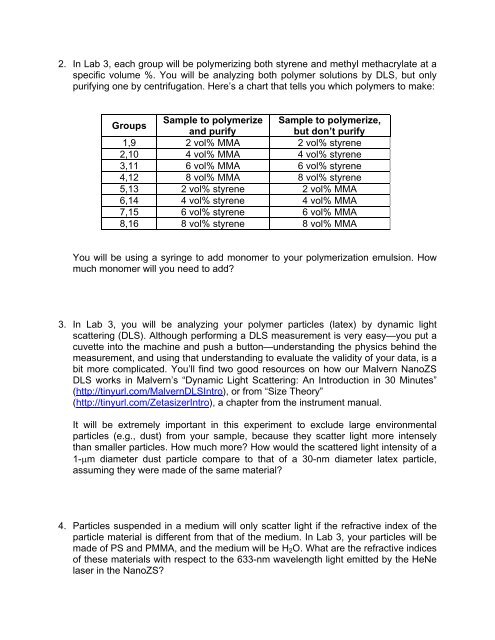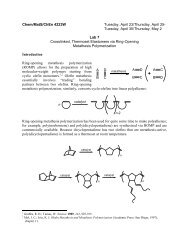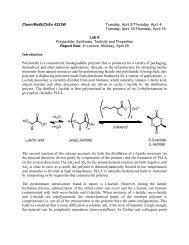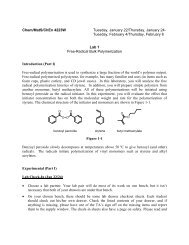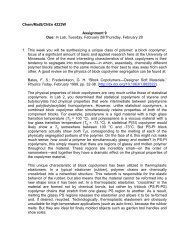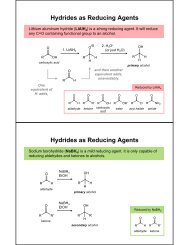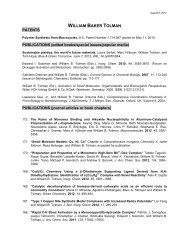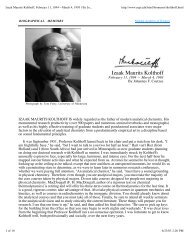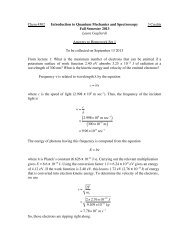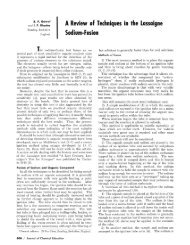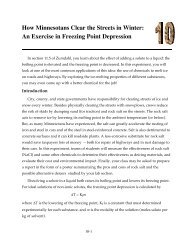Chem/MatS/ChEn 4223W Assignment 5 Due: In Lab, Tuesday ...
Chem/MatS/ChEn 4223W Assignment 5 Due: In Lab, Tuesday ...
Chem/MatS/ChEn 4223W Assignment 5 Due: In Lab, Tuesday ...
You also want an ePaper? Increase the reach of your titles
YUMPU automatically turns print PDFs into web optimized ePapers that Google loves.
2. <strong>In</strong> <strong>Lab</strong> 3, each group will be polymerizing both styrene and methyl methacrylate at aspecific volume %. You will be analyzing both polymer solutions by DLS, but onlypurifying one by centrifugation. Here’s a chart that tells you which polymers to make:GroupsSample to polymerize Sample to polymerize,and purifybut don’t purify1,9 2 vol% MMA 2 vol% styrene2,10 4 vol% MMA 4 vol% styrene3,11 6 vol% MMA 6 vol% styrene4,12 8 vol% MMA 8 vol% styrene5,13 2 vol% styrene 2 vol% MMA6,14 4 vol% styrene 4 vol% MMA7,15 6 vol% styrene 6 vol% MMA8,16 8 vol% styrene 8 vol% MMAYou will be using a syringe to add monomer to your polymerization emulsion. Howmuch monomer will you need to add?3. <strong>In</strong> <strong>Lab</strong> 3, you will be analyzing your polymer particles (latex) by dynamic lightscattering (DLS). Although performing a DLS measurement is very easy—you put acuvette into the machine and push a button—understanding the physics behind themeasurement, and using that understanding to evaluate the validity of your data, is abit more complicated. You’ll find two good resources on how our Malvern NanoZSDLS works in Malvern’s “Dynamic Light Scattering: An <strong>In</strong>troduction in 30 Minutes”(http://tinyurl.com/MalvernDLS<strong>In</strong>tro), or from “Size Theory”(http://tinyurl.com/Zetasizer<strong>In</strong>tro), a chapter from the instrument manual.It will be extremely important in this experiment to exclude large environmentalparticles (e.g., dust) from your sample, because they scatter light more intenselythan smaller particles. How much more? How would the scattered light intensity of a1-m diameter dust particle compare to that of a 30-nm diameter latex particle,assuming they were made of the same material?4. Particles suspended in a medium will only scatter light if the refractive index of theparticle material is different from that of the medium. <strong>In</strong> <strong>Lab</strong> 3, your particles will bemade of PS and PMMA, and the medium will be H 2 O. What are the refractive indicesof these materials with respect to the 633-nm wavelength light emitted by the HeNelaser in the NanoZS?


